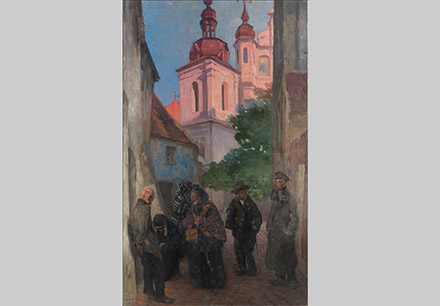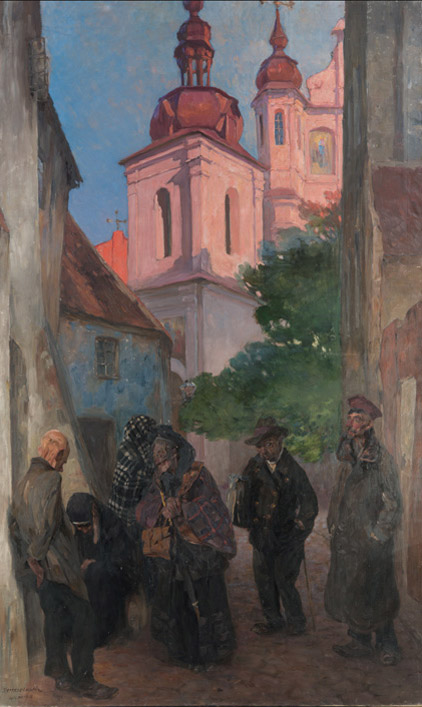
STANISŁAW
BOHUSZ-SIESTRZEŃCEWICZ
(1869–1927)
The realisation of the presentation funded
as part of the programme EU Interreg Lietuva-Polska
Project: LT-PL-5R-389
Street in Vilnius [Kitchen for the Poor]
The picture shows a group of people gathered in a Vilnius alley, waiting for a free meal. There is no feeling of community among them. Each person is carrying their humiliation in loneliness.
Also, the viewer experiences a feeling of discomfort. The picture is large. The figures of almost natural sizes are close to the observer. The composition is closed on both sides with the walls of the houses which create a narrow street. It has an overwhelming effect.
The composition is divided into two parts. The foreground is kept in dark greys and tawny tones, whereas the background is sunlit and enlivened with a pure patch of the red roof and a salmon pink facade of the Saint Michael the Archangel church set against the saturated blue of the sky. The contrast between these two spaces: earthly and spiritual is softened by an intermediary zone with the green of the dense foliage and cobalt reflections of light on the wall of the house. The juxtaposition of the dark lower section and the bright upper section, which is lifted to the sky and lit by the sun, can be interpreted as the juxtaposition of the sacrum against the profanum. It can also be read as the depiction of co-existing spheres of life. It is hard to say which interpretation is accurate as at the time when the picture was painted, in 1918, the church had been empty for many years. The juxtaposed worlds are connected with the help of subtle painting solutions: the pink check on the old lady’s coat, the gold of the umbrella handle held by her, the white of the streak in the newsboy’s eye, the golden reflexes on the buttons. The colourful and sunny upper section enlivens the dark and grey lower section.
The painting was created during times which were difficult for the citizens of Vilnius and the painter himself. The First World War was coming to a close, which meant famine and uncertainty of tomorrow as well as a sense of threat to life. In a larger perspective of identity it meant anxiety about the future destiny of the city and its national status. These feelings must have been experienced by the artist as he was capable of expressing them so vividly.
Stanisław Bohusz-Siestrzeńcewicz chose a surprisingly large format for a genre theme. Such a size is usually reserved for works with representative functions. Did he want to appoint the Vilnius citizens to heroes, noticing their pain and misery? It can then be read as a painting conveying a deeply humanistic message.









